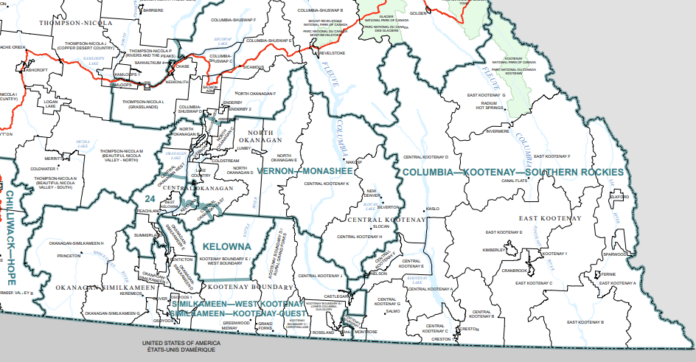New Democrat MP Richard Cannings says he will protest a proposal to split the West Kootenay between three different federal ridings.
“I can get involved and make a case for ‘let’s try to fix this the best we can to make sure the people of the West Kootenay are served properly,'” he said in an interview.
The original proposal released last year by the electoral boundaries commission would have left Cannings’ riding of South Okanagan-West Kootenay largely intact, except for adding Keremeos and splitting part of Penticton into a neighbouring riding.
However, a revised plan unveiled this month following public feedback shows much more radical changes.
South Okanagan-West Kootenay, which presently includes most of the West Kootenay plus all of the Boundary and parts of the Okanagan, would be reconfigured to take in the Similkameen and renamed Similkameen-West Kootenay.
The Slocan Valley and Arrow Lakes would be moved to a new riding called Vernon-Monashee that would also include portions of the central and north Okanagan.
The Beaver Valley and some rural areas around Castlegar including Tarrys, Thrums, and Brilliant would be moved to the East Kootenay riding, which already includes Nelson, Salmo, and Kaslo. Presently known as Kootenay-Columbia and represented by Conservative Rob Morrison, it would be renamed Columbia-Kootenay-Southern Rockies.
The exercise in boundary adjustments is carried out every 10 years and meant to even out population disparities between ridings, but Cannings says he’s concerned the public won’t have a chance to comment on the latest iteration, despite the fact it is much different than the previous one.
“That’s the main problem, there’s no avenue for real public input at this late stage,” he said.
“The only input is through myself as the MP before the House of Commons on procedure and house affairs and make an objection. That could go into a report that would come back to Elections Canada. It’s a pretty drastic change and I’m hearing a lot of comments from people.”
Cannings said the last time local ridings were adjusted, there wasn’t much change between the first and second drafts. He said there should be some mechanism where if a proposed change in a second draft covers a certain percentage of an area, it triggers an opportunity for additional public input.
He noted in the commission’s first draft, the West Kootenay was not affected at all and the lone public meeting in the region was held in Cranbrook.
“So when there was that opening for public input, people in the West Kootenay would look at the boundaries and say ‘Well, they haven’t changed. I don’t want to go to Cranbrook and say things are fine.’ So nobody spoke up. Now they have no opportunity once things have quite drastically changed.”
Cannings says generally he doesn’t think elected politicians should influence riding boundaries, but in this case he’s willing to make an exception. While population is the chief consideration in adjusting riding boundaries, he doesn’t think it should be the only one.
“You also have to take into account the communities of interest and connection. The Beaver Valley is part of Greater Trail. So much goes on between those communities that to have them separated doesn’t make any sense.
“The same goes for Brilliant and Thrums and Playmor Junction. A company like Kalesnikoff has two operations. Their South Slocan operation will have an MP in Vernon, their Thrums operation will have an MP in Cranbrook and a lot of their employees probably live in Castlegar and would have an MP with an office there.”
Cannings said he thinks average citizens are less concerned about their riding’s population than whether their neighbours are included and how far they have to go to visit their MP.
Cannings said in addition to registering his objections, he will put forward options for the commission to consider. The commission does have the latitude to recommend ridings with populations 25 per cent above or below the provincial average. Cannings said the commission has a difficult task but he is hopeful further changes can be made.
Anyone with feedback can contact his office at [email protected].
West Kootenay was always part of the same riding until 2015, when it was split between South Okanagan-West Kootenay and Kootenay-Columbia.







